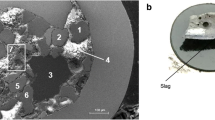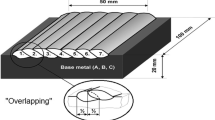Abstract
Galvanized steel sheets are widely-used in the construction and automobile industries to provide structural members with high corrosion resistance. When galvanized sheets are welded, zinc near a weld molten pool evaporates. As a result, the corrosion resistance is deteriorated and repair coating treatment is required after welding. The use of austenitic stainless steel welding materials with suitable ductility and high corrosion resistance appears to be beneficial. However, the conventional welding materials have such problems that zinc liquation cracking is likely to occur in the weld metal, a lot of welding spatter is generated and solidified slag is difficult to remove from the weld bead. To solve these problems, an austenitic stainless steel flux-cored wire was developed. Susceptibility to zinc liquation cracking was improved by increasing the ferrite content in the weld metal through the adjustment of Ni and Cr contents. The problems of the removal of solidified slag and the generation of welding spatter were solved by reducing the TiO2 content in flux to a level lower than that for a commercial wire. Thus, the weld appearance was improved, making repair coating treatment after welding unnecessary. The joints welded by the newly-developed welding material exhibited suitable mechanical properties and satisfactory corrosion resistance evaluated by salt spray testing.
Similar content being viewed by others
References
Morimoto Y.: Excellent Corrosion-resistant Zn-Al-Mg-Si Alloy Hot-dip Galvanized Steel Sheet, Nippon Steel Technical Report, January 2003, no. 87, pp. 24–26.
Elliott D.: Zinc embrittlement of stainless steel — The problem in perspective, Process Engineering, July 1976, Vol. 7, pp. 67–71.
Cottrell A.H.: Technical Lesson of Flixborough, A metallurgical examination of eight-inch line, The Chemical Engineer, April 1976, pp. 266–274.
Sadish S.: Stress cracking of stainless steel and high alloy by molten zinc at high temperature, Material Performance, 1981, Vol. 20, No. 7, pp. 16–21.
Bruscato. R.M: Liquid metal embrittlement of austenitic stainless steel when welded to galvanized steel, Welding Journal, 1992, vol. 71, no. 12, pp. 455.s–459.s.
Takeda T.: Zinc crack and 60 kilo high tensile steel for transmission line tower, Metal Science & Technology, 1999, Vol. 69, No. 3, pp. 229–237 (in Japanese).
Fujii S.: Temper color of low carbon steel, ISIJ Conference, 1971, no. 81, Proceeding report S133 (in Japanese).
Classification of metal transfer on arc electric welding processes, Doc. IIW-535-77 (ex doc. XII-636-76), Welding in the World, 1977, vol. 15, no. 5/6, pp. 113–118.
Author information
Authors and Affiliations
Corresponding authors
Rights and permissions
About this article
Cite this article
Kodama, S., Ishida, Y., Asai, K. et al. Development of Stainless Steel Welding Wire for Galvanized Steel Sheets. Weld World 54, R42–R48 (2010). https://doi.org/10.1007/BF03263483
Published:
Issue Date:
DOI: https://doi.org/10.1007/BF03263483




